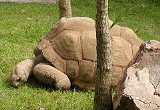
Aldabra Giant Tortoise
Encyclopedia
The Aldabra giant tortoise
(Aldabrachelys gigantea), from the islands of the Aldabra
Atoll in the Seychelles
, is one of the largest tortoise
s in the world.
This species is widely referred to as Aldabrachelys gigantea but has also been placed in the genus Dipsochelys
as Dipsochelys dussumieri.
is a brown or tan color with a high domed shape. It has stocky, heavily scaled
legs to support its heavy body. The neck of the Aldabra giant tortoise is very long, even for its great size, which helps the animal to exploit tree
branches up to a meter from the ground as a food source.
Similar in size to the famous Galápagos giant tortoise
, its carapace
averages 120 centimetres (47.2 in) in length. The average weight of a male is around 250 kilograms (551.2 lb), but one male at the Fort Worth Zoological Park weighs over 360.25 kilograms (794.2 lb). Females are generally smaller than males, with average specimens measuring 90 centimetres (35.4 in) in length and weighing 150 kilograms (330.7 lb).
Atoll in the Seychelles
. The atoll has been protected from human influence and is home to some 100,000 giant tortoises, the world's largest population of the animal. Another isolated population
of the species resides on the island of Zanzibar
, and other captive populations exist in conservation parks in Mauritius and Rodrigues. The tortoises exploit many different kinds of habitat including grassland
s, low scrub, mangrove swamps
, and coastal dunes.
s not from the tops of the plants, but closer to the ground to avoid the tortoises' close cropping jaw
s.
As the largest animal in its environment, the Aldabra tortoise performs a role similar to that of the elephant
. Their vigorous search for food fells trees and creates pathways used by other animals.
s, Aldabra giant tortoises will eat grass
es, leaves
, and woody plant stems. They occasionally indulge in small invertebrates and carrion
, even eating the bodies of other dead tortoises. In captivity, Aldabra giant tortoises are known to enjoy fruit
s such as apple
s and banana
s as well as compressed vegetable pellets.
There is little fresh water
available for drinking in the tortoises' natural habitat, therefore they obtain most of their moisture from their food.
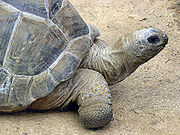 The Aldabra tortoise has two main varieties of shell. Specimens living in habitats with food available primarily on the ground have a more dome-shaped shell with front extending downward over the neck. Those living in an environment with food available higher above the ground have a more flattened top shell with the front raised to allow the neck to extend upward freely.
The Aldabra tortoise has two main varieties of shell. Specimens living in habitats with food available primarily on the ground have a more dome-shaped shell with front extending downward over the neck. Those living in an environment with food available higher above the ground have a more flattened top shell with the front raised to allow the neck to extend upward freely.
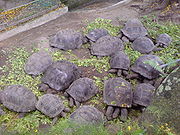 They dig underground burrows or rest in swamps to keep cool during the heat of the day.
They dig underground burrows or rest in swamps to keep cool during the heat of the day.
While they are characteristically slow and cautious, they are capable of appreciable speed. They are also known to attempt perilous acrobatic feats, rising precariously on their hind legs to reach low branches. They risk death by tipping onto their backs and being unable to right themselves.
They are also excellent swimmers, being naturally buoyant. This factor has allowed the spread and eventual speciation
of many kinds of related tortoises across the Indian Ocean
.
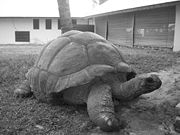 Large tortoises are among the longest-lived animals on the planet. Some individual Aldabra giant tortoises are thought to be over 200 years of age, but this is difficult to verify because they tend to outlive their human observers. Adwaita
Large tortoises are among the longest-lived animals on the planet. Some individual Aldabra giant tortoises are thought to be over 200 years of age, but this is difficult to verify because they tend to outlive their human observers. Adwaita
was reputedly one of four brought by British seamen from the Seychelles Islands as gifts to Robert Clive of the British East India Company
in the 18th century, and came to Calcutta Zoo in 1875. At its death in March 2006 at the Kolkata (formerly Calcutta) Zoo in India, Adwaita
is reputed to have reached the longest ever measured life span
of 255 years (birth year 1750). Adwaita's was determined by carbon dating his shell, making his age to be around 255 in 2006. Today, Esmeralda is thought to be the oldest living giant tortoise at 170 years old, since the death of Harriet at 176, a Galapagos giant tortoise. Esmeralda is an Aldabra giant tortoise.
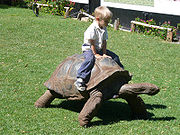
s and keep them at a comfortable temperature throughout the year (80-95°F 27-35°C).
 Between February and May, females lay between 9 and 25 rubbery eggs
Between February and May, females lay between 9 and 25 rubbery eggs
in a shallow, dry nest
. Usually less than half of the eggs are fertile. Females can produce multiple clutches of eggs in a year. After incubating for about 8 months, the tiny, independent young hatch between October and December.
In captivity, oviposition dates vary. Tulsa Zoo
maintains a small herd of Aldabra tortoises and they have reproduced several times since 1999. One female typically lays eggs in November and again in January, providing the weather is warm enough to go outside for laying. The zoo also incubates their eggs artificially, keeping two separate incubators at 81 degrees F and 86 degrees F. On average, the eggs kept at the latter temperature hatch in 107 days.
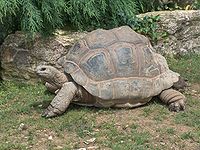 The Aldabra giant tortoise has an unusually long history of organized conservation. Albert Gunther of the British Museum, who later moved to the Natural History Museum of London (enlisting Charles Darwin
The Aldabra giant tortoise has an unusually long history of organized conservation. Albert Gunther of the British Museum, who later moved to the Natural History Museum of London (enlisting Charles Darwin
and other famous scientists to help him) worked with the government of Mauritius
to establish a preserve at the end of the 19th century. The related, but distinct, species of giant tortoise from the Seychelles islands (Seychelles giant tortoise
Dipsochelys hololissa and Arnold's giant tortoise
D. arnoldi) are the subject of a captive breeding and reintroduction program by the Nature Protection Trust of Seychelles.
Giant tortoise
Giant tortoises are characteristic reptiles of certain tropical islands. Often reaching enormous size—they can weigh as much as 300 kg and can grow to be 1.3 m long—they live, or lived , in the Seychelles, the Mascarenes and the Galapagos...
(Aldabrachelys gigantea), from the islands of the Aldabra
Aldabra
Aldabra, the world's second largest coral atoll, is in the Aldabra Group of islands in the Indian Ocean that form part of the Seychelles. Uninhabited and extremely isolated, Aldabra is virtually untouched by humans, has distinctive island fauna including the Aldabra Giant Tortoise, and is...
Atoll in the Seychelles
Seychelles
Seychelles , officially the Republic of Seychelles , is an island country spanning an archipelago of 115 islands in the Indian Ocean, some east of mainland Africa, northeast of the island of Madagascar....
, is one of the largest tortoise
Tortoise
Tortoises are a family of land-dwelling reptiles of the order of turtles . Like their marine cousins, the sea turtles, tortoises are shielded from predators by a shell. The top part of the shell is the carapace, the underside is the plastron, and the two are connected by the bridge. The tortoise...
s in the world.
This species is widely referred to as Aldabrachelys gigantea but has also been placed in the genus Dipsochelys
Dipsochelys
Dipsochelys is a genus of giant tortoise restricted to Madagascar and the Seychelles islands, containing six species:* †Dipsochelys abrupta Grandidier 1868 - Madagascar,...
as Dipsochelys dussumieri.
Anatomy and morphology
The carapaceCarapace
A carapace is a dorsal section of the exoskeleton or shell in a number of animal groups, including arthropods such as crustaceans and arachnids, as well as vertebrates such as turtles and tortoises. In turtles and tortoises, the underside is called the plastron.-Crustaceans:In crustaceans, the...
is a brown or tan color with a high domed shape. It has stocky, heavily scaled
Scale (zoology)
In most biological nomenclature, a scale is a small rigid plate that grows out of an animal's skin to provide protection. In lepidopteran species, scales are plates on the surface of the insect wing, and provide coloration...
legs to support its heavy body. The neck of the Aldabra giant tortoise is very long, even for its great size, which helps the animal to exploit tree
Tree
A tree is a perennial woody plant. It is most often defined as a woody plant that has many secondary branches supported clear of the ground on a single main stem or trunk with clear apical dominance. A minimum height specification at maturity is cited by some authors, varying from 3 m to...
branches up to a meter from the ground as a food source.
Similar in size to the famous Galápagos giant tortoise
Galápagos tortoise
The Galápagos tortoise or Galápagos giant tortoise is the largest living species of tortoise, reaching weights of over and lengths of over . With life spans in the wild of over 100 years, it is one of the longest-lived vertebrates...
, its carapace
Carapace
A carapace is a dorsal section of the exoskeleton or shell in a number of animal groups, including arthropods such as crustaceans and arachnids, as well as vertebrates such as turtles and tortoises. In turtles and tortoises, the underside is called the plastron.-Crustaceans:In crustaceans, the...
averages 120 centimetres (47.2 in) in length. The average weight of a male is around 250 kilograms (551.2 lb), but one male at the Fort Worth Zoological Park weighs over 360.25 kilograms (794.2 lb). Females are generally smaller than males, with average specimens measuring 90 centimetres (35.4 in) in length and weighing 150 kilograms (330.7 lb).
Range and distribution
The main population of the Aldabra giant tortoise resides on the islands of the AldabraAldabra
Aldabra, the world's second largest coral atoll, is in the Aldabra Group of islands in the Indian Ocean that form part of the Seychelles. Uninhabited and extremely isolated, Aldabra is virtually untouched by humans, has distinctive island fauna including the Aldabra Giant Tortoise, and is...
Atoll in the Seychelles
Seychelles
Seychelles , officially the Republic of Seychelles , is an island country spanning an archipelago of 115 islands in the Indian Ocean, some east of mainland Africa, northeast of the island of Madagascar....
. The atoll has been protected from human influence and is home to some 100,000 giant tortoises, the world's largest population of the animal. Another isolated population
Population
A population is all the organisms that both belong to the same group or species and live in the same geographical area. The area that is used to define a sexual population is such that inter-breeding is possible between any pair within the area and more probable than cross-breeding with individuals...
of the species resides on the island of Zanzibar
Zanzibar
Zanzibar ,Persian: زنگبار, from suffix bār: "coast" and Zangi: "bruin" ; is a semi-autonomous part of Tanzania, in East Africa. It comprises the Zanzibar Archipelago in the Indian Ocean, off the coast of the mainland, and consists of numerous small islands and two large ones: Unguja , and Pemba...
, and other captive populations exist in conservation parks in Mauritius and Rodrigues. The tortoises exploit many different kinds of habitat including grassland
Grassland
Grasslands are areas where the vegetation is dominated by grasses and other herbaceous plants . However, sedge and rush families can also be found. Grasslands occur naturally on all continents except Antarctica...
s, low scrub, mangrove swamps
Mangrove
Mangroves are various kinds of trees up to medium height and shrubs that grow in saline coastal sediment habitats in the tropics and subtropics – mainly between latitudes N and S...
, and coastal dunes.
Habitat
A peculiar kind of habitat has co-evolved due to the grazing pressures of the tortoises: "tortoise turf," a comingling of 20+ species of grasses and herbs. Many of these distinct plants are naturally dwarfed and grow their seedSeed
A seed is a small embryonic plant enclosed in a covering called the seed coat, usually with some stored food. It is the product of the ripened ovule of gymnosperm and angiosperm plants which occurs after fertilization and some growth within the mother plant...
s not from the tops of the plants, but closer to the ground to avoid the tortoises' close cropping jaw
Jaw
The jaw is any opposable articulated structure at the entrance of the mouth, typically used for grasping and manipulating food. The term jaws is also broadly applied to the whole of the structures constituting the vault of the mouth and serving to open and close it and is part of the body plan of...
s.
As the largest animal in its environment, the Aldabra tortoise performs a role similar to that of the elephant
Elephant
Elephants are large land mammals in two extant genera of the family Elephantidae: Elephas and Loxodonta, with the third genus Mammuthus extinct...
. Their vigorous search for food fells trees and creates pathways used by other animals.
Feeding ecology
Primarily herbivoreHerbivore
Herbivores are organisms that are anatomically and physiologically adapted to eat plant-based foods. Herbivory is a form of consumption in which an organism principally eats autotrophs such as plants, algae and photosynthesizing bacteria. More generally, organisms that feed on autotrophs in...
s, Aldabra giant tortoises will eat grass
Grass
Grasses, or more technically graminoids, are monocotyledonous, usually herbaceous plants with narrow leaves growing from the base. They include the "true grasses", of the Poaceae family, as well as the sedges and the rushes . The true grasses include cereals, bamboo and the grasses of lawns ...
es, leaves
Leaf
A leaf is an organ of a vascular plant, as defined in botanical terms, and in particular in plant morphology. Foliage is a mass noun that refers to leaves as a feature of plants....
, and woody plant stems. They occasionally indulge in small invertebrates and carrion
Carrion
Carrion refers to the carcass of a dead animal. Carrion is an important food source for large carnivores and omnivores in most ecosystems. Examples of carrion-eaters include vultures, hawks, eagles, hyenas, Virginia Opossum, Tasmanian Devils, coyotes, Komodo dragons, and burying beetles...
, even eating the bodies of other dead tortoises. In captivity, Aldabra giant tortoises are known to enjoy fruit
Fruit
In broad terms, a fruit is a structure of a plant that contains its seeds.The term has different meanings dependent on context. In non-technical usage, such as food preparation, fruit normally means the fleshy seed-associated structures of certain plants that are sweet and edible in the raw state,...
s such as apple
Apple
The apple is the pomaceous fruit of the apple tree, species Malus domestica in the rose family . It is one of the most widely cultivated tree fruits, and the most widely known of the many members of genus Malus that are used by humans. Apple grow on small, deciduous trees that blossom in the spring...
s and banana
Banana
Banana is the common name for herbaceous plants of the genus Musa and for the fruit they produce. Bananas come in a variety of sizes and colors when ripe, including yellow, purple, and red....
s as well as compressed vegetable pellets.
There is little fresh water
Water
Water is a chemical substance with the chemical formula H2O. A water molecule contains one oxygen and two hydrogen atoms connected by covalent bonds. Water is a liquid at ambient conditions, but it often co-exists on Earth with its solid state, ice, and gaseous state . Water also exists in a...
available for drinking in the tortoises' natural habitat, therefore they obtain most of their moisture from their food.

Tortoise turf
Tortoise turf is composed of the following plant species:
|
Solanum nigrum Solanum nigrum is a species in the Solanum genus, native to Eurasia and introduced in the Americas, Australasia and South Africa.-Description:Black... Sporobolus virginicus Sporobolus virginicus, known by numerous common names including Marine Couch, Sand Couch, Coastal Rat-tail Grass, Salt Couch Grass, Saltwater Couch and Nioaka, is a coastal non-bunching tussock grass with a wide distribution.-Description:It is a perennial tussock grass from 10 to 50 centimetres in... |
Behavior
Aldabra tortoises are found both individually and in herds, which tend to gather mostly on open grasslands. They are most active in the mornings when they spend time browsing for food.
While they are characteristically slow and cautious, they are capable of appreciable speed. They are also known to attempt perilous acrobatic feats, rising precariously on their hind legs to reach low branches. They risk death by tipping onto their backs and being unable to right themselves.
They are also excellent swimmers, being naturally buoyant. This factor has allowed the spread and eventual speciation
Speciation
Speciation is the evolutionary process by which new biological species arise. The biologist Orator F. Cook seems to have been the first to coin the term 'speciation' for the splitting of lineages or 'cladogenesis,' as opposed to 'anagenesis' or 'phyletic evolution' occurring within lineages...
of many kinds of related tortoises across the Indian Ocean
Indian Ocean
The Indian Ocean is the third largest of the world's oceanic divisions, covering approximately 20% of the water on the Earth's surface. It is bounded on the north by the Indian Subcontinent and Arabian Peninsula ; on the west by eastern Africa; on the east by Indochina, the Sunda Islands, and...
.
Life history

Adwaita
Adwaita was the name of a male Aldabra giant tortoise in the Alipore Zoological Gardens of Kolkata, India...
was reputedly one of four brought by British seamen from the Seychelles Islands as gifts to Robert Clive of the British East India Company
British East India Company
The East India Company was an early English joint-stock company that was formed initially for pursuing trade with the East Indies, but that ended up trading mainly with the Indian subcontinent and China...
in the 18th century, and came to Calcutta Zoo in 1875. At its death in March 2006 at the Kolkata (formerly Calcutta) Zoo in India, Adwaita
Adwaita
Adwaita was the name of a male Aldabra giant tortoise in the Alipore Zoological Gardens of Kolkata, India...
is reputed to have reached the longest ever measured life span
Maximum life span
Maximum life span is a measure of the maximum amount of time one or more members of a population has been observed to survive between birth and death.Most living species have at least one upper limit on the number of times cells can divide...
of 255 years (birth year 1750). Adwaita's was determined by carbon dating his shell, making his age to be around 255 in 2006. Today, Esmeralda is thought to be the oldest living giant tortoise at 170 years old, since the death of Harriet at 176, a Galapagos giant tortoise. Esmeralda is an Aldabra giant tortoise.

In captivity
The Aldabra tortoise is recently becoming more available in the pet trade. They may require a permit. The price still makes them somewhat of an exclusive animal. Care for these tortoises requires a good deal of commitment. They are very powerful as adults, and can be destructive in a typical suburban setting; capable of ramming through fences and doors. Fairly expensive accommodations are necessary to contain these tortoiseTortoise
Tortoises are a family of land-dwelling reptiles of the order of turtles . Like their marine cousins, the sea turtles, tortoises are shielded from predators by a shell. The top part of the shell is the carapace, the underside is the plastron, and the two are connected by the bridge. The tortoise...
s and keep them at a comfortable temperature throughout the year (80-95°F 27-35°C).
Breeding

Egg (biology)
An egg is an organic vessel in which an embryo first begins to develop. In most birds, reptiles, insects, molluscs, fish, and monotremes, an egg is the zygote, resulting from fertilization of the ovum, which is expelled from the body and permitted to develop outside the body until the developing...
in a shallow, dry nest
Nest
A nest is a place of refuge to hold an animal's eggs or provide a place to live or raise offspring. They are usually made of some organic material such as twigs, grass, and leaves; or may simply be a depression in the ground, or a hole in a tree, rock or building...
. Usually less than half of the eggs are fertile. Females can produce multiple clutches of eggs in a year. After incubating for about 8 months, the tiny, independent young hatch between October and December.
In captivity, oviposition dates vary. Tulsa Zoo
Tulsa Zoo
The Tulsa Zoo and Living Museum is a zoo and living museum located in Tulsa, Oklahoma USA. The Tulsa Zoo is owned by the city of Tulsa and is part of the Tulsa Parks Department. The zoo is located in Mohawk Park, one of the largest municipal parks in the United States...
maintains a small herd of Aldabra tortoises and they have reproduced several times since 1999. One female typically lays eggs in November and again in January, providing the weather is warm enough to go outside for laying. The zoo also incubates their eggs artificially, keeping two separate incubators at 81 degrees F and 86 degrees F. On average, the eggs kept at the latter temperature hatch in 107 days.
Conservation

Charles Darwin
Charles Robert Darwin FRS was an English naturalist. He established that all species of life have descended over time from common ancestry, and proposed the scientific theory that this branching pattern of evolution resulted from a process that he called natural selection.He published his theory...
and other famous scientists to help him) worked with the government of Mauritius
Mauritius
Mauritius , officially the Republic of Mauritius is an island nation off the southeast coast of the African continent in the southwest Indian Ocean, about east of Madagascar...
to establish a preserve at the end of the 19th century. The related, but distinct, species of giant tortoise from the Seychelles islands (Seychelles giant tortoise
Seychelles giant tortoise
The Seychelles giant tortoise has been thought to be extinct since the mid-19th century due to overexploitation on the granitic Seychelles islands. Similar giant tortoise species on other Indian Ocean islands such as Mauritius, Réunion and Rodrigues Island are also extinct...
Dipsochelys hololissa and Arnold's giant tortoise
Arnold's Giant Tortoise
Arnold's giant tortoise , also known as the Seychelles saddle-backed tortoise, inhabited the granitic Seychelles islands until around 1840, when it was presumed to be extinct, along with the Seychelles giant tortoise; a species which shared the same islands.The report of oddly-shaped of tortoises...
D. arnoldi) are the subject of a captive breeding and reintroduction program by the Nature Protection Trust of Seychelles.

